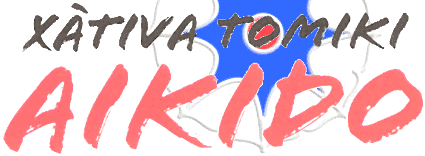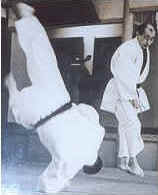You should always keep your body clean
and well groomed, finger, nails and toenails should be kept short. No jewellery
or metal items of any kind should be worn during training.
No food or drink should be taken into
the dojo at any time. Liquid refreshment should be restricted only to
water and this should only be allowed at the teachers discretion and only
under special conditions or circumstances.
All graded students should wear a clean
Gi when training. In this way, all students are equal, it is not possible
to judge the station in life, profession, or ability by uniform. The only
means to evaluate the person as an Aikido student is to watch his or her
techniques and evaluate them against other of equal experience, grade or
standing. This is as it should be.
The Aikido student's Gi (Uniform) should
be white. The Gi should always be kept clean, neat and in good repair. It
should be worn closed left over right for both sexes. Usually men and boys
wear nothing under their Gi top. Ladies and girls should wear a plain
white t-shirt under their top.
Rei (Bow)
In the Dojo there is a formalised etiquette. Covering how to greet people,
how to enter and leave the Dojo, how to tidy your Gi and how to tie your
belt. These formalities are observed by all Aikido students, regardless of
grade.
Etiquette is not a question of
rank
Courtesy is based on respect; for oneself, for others and for the Dojo
(Training Hall). The basic expression of respect and courtesy, which comes
from Japanese culture, is the bow or Rei but can also mean courtesy. These
are two positions from which to bow - standing and kneeling.
The Standing Bow or Rei
Is performed with the feet close together and the hands, palm open and
held close to the side (against the side seam of the trousers). In Japan
ladies and girls place their hands flat against their thighs. The bow or
Rei is performed from the hips. Not just a nod of the head, dip of the
shoulders or bending at the waist. The head and eyes must remain
aligned and you should not be tempted look up or forward.
The Kneeling Bow or Rei
This is performed in what is known as "Seiza" or Kneeling
posture, you should use your left knee first, followed by the right knee. This
originates from the days when the Samurai wore their Katana or long sword
(usually on their left side). When sitting the feet should be crossed at
the toes, with the knees about six to eight inches apart (two fists
width). The hands should rest, palms open and down on the thighs.
When bowing from this position the head
should never touch the ground. You should look about 6 to 8 feet in front
of you and bow from the hips. Your hands should be placed palm down. First
left then the right. The hands should form a triangle using the thumbs and
fore fingers. Once again this comes from the days of the Samurai.
By placing the left hand down first it showed that you meant no harm,
because you could not draw your sword from this position. The bow is
complete when you return to the upright position.
When entering or leaving the Dojo, you
should stop just inside the doorway, face the shrine or Joseki (the place
where the Teacher and or V.I.P.'s. sit) and perform a standing Rei. Should a
student arrive when a class is in progress he or she should enter the Dojo
make a standing Rei, then kneel down in "Seiza" and wait to be
invited to join the class, either by the Teacher or by his senior
assistant. Once invited stand up make a standing bow to the shrine or
Joseki and join the class.
Before a lesson begins the class will
line up, in grade order with the senior grade nearest the Kamiza or Joseki. The senior
student will say "Seiza" followed by "Kamiza" or
"Shomen-ni-Rei" followed by "Sensei-ni-Rei". When the
lesson ends the class will line up as at the beginning. The senior grade
will call "Seiza" then "Mokuso", which means silent
meditation. You should sit with your eyes half closed thinking about what
you have been taught during the lesson. Breathing in deeply through the
nose and out through the mouth.
This period of meditation will stop when
the senior grade calls "Yame" (this means end). The next
command will be "Sensei-ni-Rei". The class bow to the teacher
and he or she returns the bow. The next command is "Kamiza-ni-Rei".
The class turn to the Kamiza or Joseki and bow again.
The class remain seated until the
Teacher and senior grades stand up. Here again when you leave the Dojo you
should face the shrine or joseki and bow.
This bowing, is not a sign of subservience but a sign of respect shown to
the whole aspect of, the Dojo, your Teacher, your fellow students,
training with you and for the privilege of being allowed to study the
activity.



